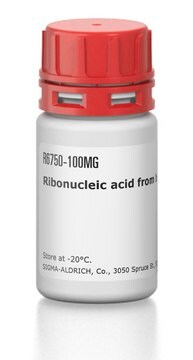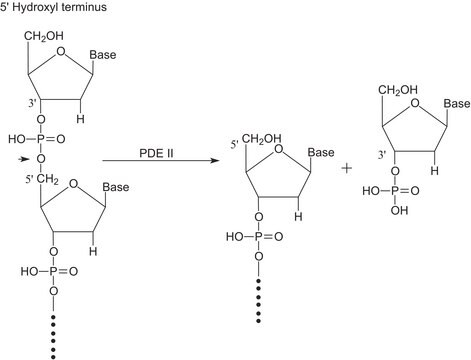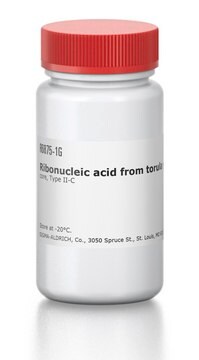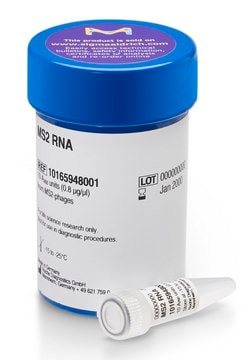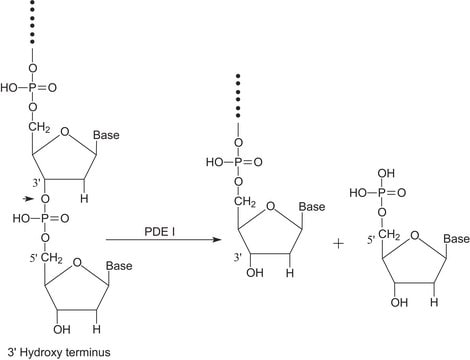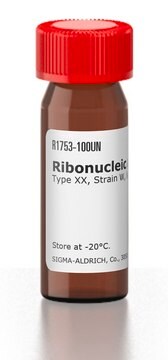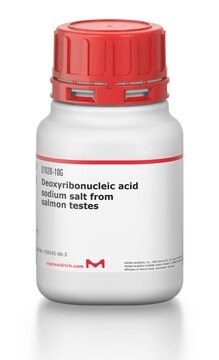R6625
Ribonucleic acid from torula yeast
Type VI
Synonyme(s) :
RNA
Se connecterpour consulter vos tarifs contractuels et ceux de votre entreprise/organisme
About This Item
Produits recommandés
Vous recherchez des produits similaires ? Visite Guide de comparaison des produits
Description générale
Ribonucleic Acid (RNA) from torula yeast is the substrate for the RNase enzyme. The isolation of RNA from yeast is a complicated process and involves heating and freezing cycles of cells in the presence of phenyl and detergents (SDS).
Application
Ribonucleic Acid (RNA) is suitable for applications such as northern blot hybridization, reverse transcriptase-polymerase chain reaction (RTPCR), and cDNA construction.
Ribonucleic acid (RNA) from torula yeast may be used as a substrate for studying ribonuclease activities of enzymes such as ribonuclease-A, ribonuclease T1 (RNAase), and bougainvillea xbuttiana antiviral protein 1 (BBAP1)
Ribonucleic acid (RNA) from torula yeast may be used as a substrate for studying ribonuclease activities of enzymes such as ribonuclease-A, ribonuclease T1 (RNAase), and bougainvillea xbuttiana antiviral protein 1 (BBAP1)
Qualité
Phosphorus: 8.0-10.0% (anhydrous)
Code de la classe de stockage
11 - Combustible Solids
Classe de danger pour l'eau (WGK)
WGK 3
Point d'éclair (°F)
Not applicable
Point d'éclair (°C)
Not applicable
Équipement de protection individuelle
Eyeshields, Gloves, type N95 (US)
Faites votre choix parmi les versions les plus récentes :
Déjà en possession de ce produit ?
Retrouvez la documentation relative aux produits que vous avez récemment achetés dans la Bibliothèque de documents.
Les clients ont également consulté
Jay S Petrick et al.
Regulatory toxicology and pharmacology : RTP, 81, 57-68 (2016-10-30)
Genetically modified (GM) crops have been developed and commercialized that utilize double stranded RNAs (dsRNA) to suppress a target gene(s), producing virus resistance, nutritional and quality traits. MON 87411 is a GM maize variety that leverages dsRNAs to selectively control
Michael R Green et al.
Cold Spring Harbor protocols, 2021(12) (2021-12-03)
Isolation of RNA from yeast is complicated by the need to first break the thick, rigid cell wall. The protocol provided here uses a cycle of heating and freezing of cells in the presence of phenol and the detergent sodium
E S Trombetta et al.
The Journal of cell biology, 148(6), 1123-1129 (2000-03-22)
Newly synthesized glycoproteins interact during folding and quality control in the ER with calnexin and calreticulin, two lectins specific for monoglucosylated oligosaccharides. Binding and release are regulated by two enzymes, glucosidase II and UDP-Glc:glycoprotein:glycosyltransferase (GT), which cyclically remove and reattach
Stephanie L Grillo et al.
Purinergic signalling, 15(3), 327-342 (2019-07-06)
Adenosine is an endogenous nucleoside in the central nervous system that acts on adenosine receptors. These are G protein-coupled receptors that have four known subtypes: A1, A2A, A2B, and A3 receptors. In the present study, we aimed to map the
Jesus E Martinez-Lopez et al.
Frontiers in neuroanatomy, 9, 12-12 (2015-03-06)
In the study of central nervous system morphogenesis, the identification of new molecular markers allows us to identify domains along the antero-posterior and dorso-ventral (DV) axes. In the past years, the alar and basal plates of the midbrain have been
Notre équipe de scientifiques dispose d'une expérience dans tous les secteurs de la recherche, notamment en sciences de la vie, science des matériaux, synthèse chimique, chromatographie, analyse et dans de nombreux autres domaines..
Contacter notre Service technique
